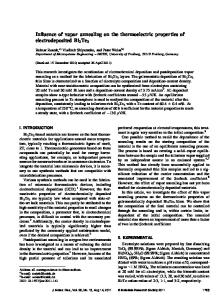Thermoelectric and transport properties of nanostructured Bi 2 Te 3 by spark plasma sintering
- PDF / 989,024 Bytes
- 10 Pages / 584.957 x 782.986 pts Page_size
- 36 Downloads / 364 Views
Peter A. Sharma Sandia National Laboratories, Energy Nanomaterials Sciences, Livermore, California 94551-0969
Enrique J. Lavernia University of California, Davis, Department of Chemical Engineering and Materials Science, Davis, California 95616
Nancy Yang Sandia National Laboratories, Energy Nanomaterials Sciences, Livermore, California 94551-0969 (Received 15 June 2010; accepted 13 October 2010)
N-type Bi2Te3 alloys with different microstructural length scales were prepared by mechanical milling and spark plasma sintering (SPS). The electrical resistivity, thermal conductivity, Seebeck coefficient, carrier concentration, and Hall mobility along and perpendicular to the loading direction were determined and characterized. The SPS sintered bulk disks using nanostructured powder contain high nanoporosity and weak (00l) texture along the loading axis, in contrast to those obtained with coarse powder. The influence of nanoporosity and texture on the thermoelectric and transport properties in the n-type Bi2Te3 alloys is discussed in light of the microstructural characteristics at different length scales.
I. INTRODUCTION
Thermoelectric (TE) materials are becoming increasingly important in the search for alternative sources for energy harvesting and conversion. Bi2Te3-based alloys are commonly accepted to be the best thermoelectric materials for near-room-temperature applications due to their high figure of merit.1–3 Recently, the figure of merit in a p-type (Bi0.25Sb0.75)2Te3 bulk alloy was further improved with an approximate 40% increase of its peak value at 373 K by hot pressing mechanically milled nmscale powder.4 Electrical transport measurements and microstructural observations show that the ZT improvement is attributed to low thermal conductivity caused by increased phonon scattering by grain boundaries and defects. This discovery validates the nanocomposite approach in developing high performance low-cost bulk thermoelectric materials.5 The efficiency of a thermoelectric device is determined by the materials’ dimensionless figure of merit, defined as ZT 5 S2T/(qj), where S is the Seebeck coefficient, q is the electrical resistivity, and j is the thermal conductivity. Due to the interdependence of the various thermoelectric parameters, a viable strategy for maximizing ZT is first to maximize the power factor (S2T/ q), for example, via tailoring the chemistry by doping, and then to minimize the lattice thermal conductivity by a)
Address all correspondence to this author. e-mail: [email protected] DOI: 10.1557/jmr.2010.67 J. Mater. Res., Vol. 26, No. 3, Feb 14, 2011
increasing the degree of phonon scattering. By incorporating the concept of a nanostructured material, a composite system has the theoretical potential to benefit from both quantum confinement effects and grain boundary scattering of phonons, resulting in enhanced thermopower and lowered thermal conductivity, respectively. Therefore, it is of interest to study the nanoscale size effects on the transport properties of the Bi2Te3 system. The Bi2Te3 alloys h
Data Loading...











